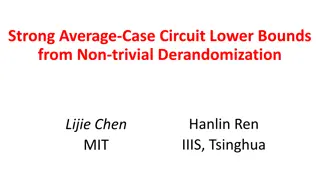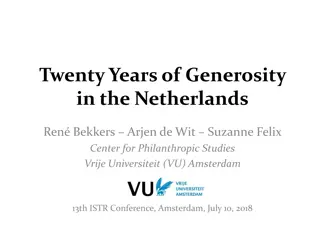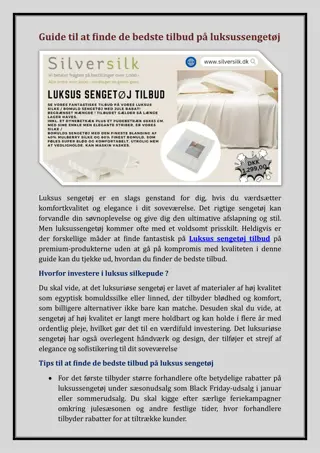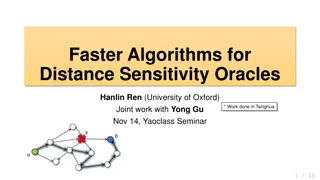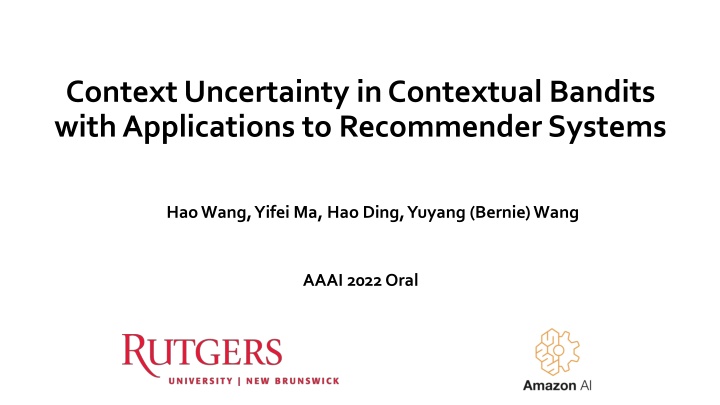
Latent Representations in Modern Recommender Systems
Explore the concept of latent representations in modern recommender systems, from matrix factorization to collaborative deep learning and recurrent neural networks. Understand how these representations influence the performance of recommendation algorithms and the importance of effective exploration in addressing the chicken-and-egg problem.
Download Presentation

Please find below an Image/Link to download the presentation.
The content on the website is provided AS IS for your information and personal use only. It may not be sold, licensed, or shared on other websites without obtaining consent from the author. If you encounter any issues during the download, it is possible that the publisher has removed the file from their server.
You are allowed to download the files provided on this website for personal or commercial use, subject to the condition that they are used lawfully. All files are the property of their respective owners.
The content on the website is provided AS IS for your information and personal use only. It may not be sold, licensed, or shared on other websites without obtaining consent from the author.
E N D
Presentation Transcript
Context Uncertainty in Contextual Bandits with Applications to Recommender Systems Hao Wang, Yifei Ma, Hao Ding, Yuyang (Bernie) Wang AAAI 2022 Oral
2 Recommender Systems Rating matrix: Observed preferences: Matrix completion To predict:
3 Latent Representations in Modern Recommender Systems Latent Representation via Matrix Factorization Latent representation (factors) ? for a user Latent representation (factors) ? for an item Predict the rating from a user to an item using the inner product ?? ? Koren et al. Matrix factorization techniques for recommender systems. Computer 42.8 (2009): 30-37.
4 Latent Representations in Modern Recommender Systems Deep Latent Representation via Collaborative Deep Learning Additionally, learn latent representation ? for a user and latent offset ?for an item Deep latent representation ? for an item from neural networks Predict the rating from a user to an item using the inner product ?? (? + ?) Wang et al. Collaborative deep learning for recommender systems. KDD 2015. Wang et al. Collaborative recurrent AE for recommender systems. NIPS 2016.
5 Latent Representations in Modern Recommender Systems Deep Latent Representation via Recurrent Neural Networks Deep latent representation ? for a user at time ? + 1 Additionally, learn latent representation ? for each item Predict the rating from a user to an item using the inner product ?? ? Performance relies heavily on the quality of representations in the latent space Hidasi et al. Session-based recommendations with recurrent neural networks. ICLR 2016. Ma et al. Temporal-Contextual Recommendation in Real-Time. KDD 2020.
6 The Need for Exploration Reward (Accuracy) Time Find the user likes action movies, and keep recommending her action movies. Reward increases. Reward saturated.
7 The Need for Exploration Reward (Accuracy) Time Find the user likes action movies, recommend her action movies and other movies. Reward increases. Reward keep increasing.
8 Chicken-and-Egg Problem Recommendations rely on learned latent representations Need Good Latent Representations Effective Exploration Need Exploration happens in the latent space
9 Solution: Context Uncertainty Recommendations rely on learned latent representations Context Uncertainty (Latent Representation Uncertainty) Effective Exploration Good Latent Representations
10 Relevance + Diversity For one user at time ?, the score for item ? is: Latent representation for this user at time t Latent representation for item k Relevance Term Diversity Term
11 Relevance + Diversity For one user at time ?, the score for item ? is: Collection of latent representations for t-1 items this user purchased before time t Relevance Term Diversity Term
12 Relevance + Diversity For one user at time ?, the score for item ? is: Measures what has been explored: the latent space this user has explored until time t Relevance Term Diversity Term
13 Relevance + Diversity For one user at time ?, the score for item ? is: Measures what has been explored (regularized): the latent space this user has explored until time t Relevance Term Diversity Term
14 Relevance + Diversity For one user at time ?, the score for item ? is: Measures what has NOT been explored: the latent space this user has NOT explored until time t Relevance Term Diversity Term
15 Relevance + Diversity For one user at time ?, the score for item ? is: Diversity score for item k: how item k is different from this user s previous items Relevance Term Diversity Term Exploration based on diversity in the latent space. Is it sufficient?
16 Relevance + Diversity: Not Good Enough For one user at time ?, the score for item ? is: Diversity score for item k Relevance Term Diversity Term Not good enough. Example: Item 1 representation ?? happens to be initialized as ? NOT certain about ??= ? . Latent representation is the same for all items k: ??= ? , ? All items have identical diversity scores
17 Relevance + Diversity: Not Good Enough For one user at time ?, the score for item ? is: Relevance Term Diversity Term To capture uncertainty, consider both mean and variance of item representation ?? ?) (??,?? ?? ? ? ? ? ??= ????=? ??= ????=?
18 Relevance + Diversity + Uncertainty For one user at time ?, the score for item ? is: Relevance Term Diversity Term Uncertainty Term
19 Relevance + Diversity + Uncertainty For one user at time ?, the score for item ? is: Uncertainty score for item k: how uncertain about item k s representation ||??|| gets smaller as we see more data At the beginning, item k s representation will have high uncertainty, i.e., large ||??|| System will tend to recommend Item k more frequently
20 Compatible with Any Base Model as long as the base model uses latent representations ?( ) can be any base model Recurrent neural networks or RNN (GRU, TCN, HRNN, etc.) Transformer Matrix factorization
21 Recurrent Exploration Networks (REN): Compatible with Any Base Model REN-G (GRU4Rec w/ REN) REN-T (TCN w/ REN) REN-H (HRNN w/ REN) GRU4Rec TCN HRNN
22 Theoretical Analysis Lemma 1 (Informal, Confidence Bound). For a user at time ?, the difference between REN s estimated reward and the true reward for item ? is bounded by a weighted sum of the diversity term and the uncertainty term. Theorem 1 (Informal, Regret Bound). After T time steps, the difference between the optimal cumulative reward and REN s achieved cumulative reward (i.e., the regret) has a sublinear bound, i.e., ?( ? ln3?ln ? ). Rate-optimal sublinear bound. The average regret (regret/T) converges to zero as ? approaches +
23 Reward Uncertainty versus Context Uncertainty ?? + ? ??= ?? Reward Uncertainty in Typical Contextual Bandits: Deterministic context: problematic if ?? is latent Reward uncertainty: independent of ?? ?? + ? ??= ?? Context Uncertainty in Our REN: Probabilistic context: ?? ?(??,?? ?represents context uncertainty Reward uncertainty: independent of ?? ?) ??
24 Toy Datasets and Simulated Environment 8= 28 unique items (i.e., items Three Toy Datasets with ?2 with different ground-truth 8D latent representations ??): SYN-S: 15 users, 28 items SYN-M: 15 users, 28*10=280 items SYN-L: 15 users, 28*100=2800 items Simulated Environment: At each time step t, (1) randomly choose one user, (2) ask the model to recommend 4 items, and (3) return the reward
25 Baselines (Base Models) Focus on sequential base models GRU4Rec: Gated recurrent units for session-based recommendation TCN: Temporal convolutional networks for sequential recommendation HRNN: Hierarchical recurrent neural networks for sequential recommendation
26 Toy Dataset: SYN-S REN-G (GRU4Rec w/ REN) REN-T (TCN w/ REN) REN-H (HRNN w/ REN) GRU4Rec TCN HRNN Our REN can use any base models and improve long-term rewards
27 Toy Dataset: SYN-S REN-H (HRNN w/ REN) HRNN Our REN can use any base models and improve long-term rewards
28 Toy Dataset: SYN-M and SYN-L Similar improvements in SYN-M and SYN-L
29 Ablation Study: Diversity Term and Uncertainty Term SYN-L, REN-1,2,3: w/ diversity item SYN-L, REN-1,3: w/o diversity term Diversity term helps effective exploration in the compact latent space when the item space is large (e.g., 2800 items)
30 Ablation Study: Diversity Term and Uncertainty Term SYN-L, REN-1,2,3: w/ uncertainty item SYN-L, REN-1,2: w/o uncertainty term
31 Ablation Study: Diversity Term and Uncertainty Term SYN-S, REN-1,2,3: w/ uncertainty item SYN-S, REN-1,2: w/o uncertainty term Uncertainty term helps explore uncertain items and pushes long- term rewards closer to the optimum (oracle)
32 Evaluation on Real-World Datasets Three Recommender System Datasets MovieLens-1M: 6040 users, 3900 items, 1M interactions Netflix (subset): 480K users, 17K items, 100M interactions Trivago: 730K users, 926K items, 910K interactions
33 MovieLens-1M: Results REN-H (HRNN w/ REN) REN-T (TCN w/ REN) REN-G (GRU4Rec w/ REN) HRNN TCN GRU4Rec
34 Netflix: Results REN-H (HRNN w/ REN) HRNN Our REN performs effective exploration to achieve higher long-term reward
35 Trivago: Slightly Different Setting, Impression Data MovieLens-1M and Netflix: At each time t, models recommend items from the entire item set (3900 items and 17K items) Trivago: At each time t, models recommend items from a candidate set of 25 items that have been shown to users (i.e., impression data), instead of the entire set of 926K items
36 Trivago: Results REN-G (GRU4Rec w/ REN) REN-T (TCN w/ REN) REN-H (HRNN w/ REN) GRU4Rec TCN HRNN Our REN performs effective exploration to prevent accuracy drop (maintain high accuracy)
37 Summary Identify a chicken-and-egg problem when exploring in the latent space. Framework of context uncertainty (e.g., REN) that handle this problem. Theoretical guarantees that REN achieves the rate-optimal regret bound. State-of-the-art performance on both synthetic and real-world RecSys datasets. More details at http://wanghao.in/paper/AAAI22_REN.pdf.









